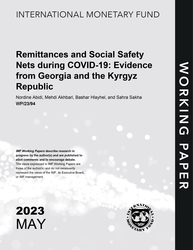
Remittances and Social Safety Nets During COVID-19: Evidence From Georgia and the Kyrgyz Republic
Remittances and Social Safety Nets During COVID-19: Evidence From Georgia and the Kyrgyz Republic
READ MORE...
Volume/Issue:
Volume 2023
Issue 094
Publication date: May 2023
ISBN: 9798400240966
$20.00
Add to Cart by clicking price of the language and format you'd like to purchase
Available Languages and Formats
| English |
Prices in red indicate formats that are not yet available but are forthcoming.
Topics covered in this book
This title contains information about the following subjects.
Click on a subject if you would like to see other titles with the same subjects.
Exports and Imports , Economics- Macroeconomics , Public Finance , Economics / General , COVID-19 , Remittances , Central Asia , remittance-receiving household , household income , remittance flow , households in Georgia , remittance-sending country , remittance receiver , Income , Social assistance spending , Income distribution , North America , Middle East and Central Asia , Global
Summary
Remittance flows in emerging market and developing economies were surprisingly resilient during the COVID-19 crisis, providing much-needed income support for remittance-receiving households. However, households were impacted differently across income distributions. Using novel high-frequency household panel data for Georgia and the Kyrgyz Republic and a difference-in-differences approach, we find that as household income fell during the pandemic, remittance-receiving households were more affected than non-remittance-receiving households. Importantly, we find that the incomes of poor, remittance-receiving households in the Kyrgyz Republic were more adversely affected than their non-remittance-receiving counterparts. In contrast, in Georgia, affluent remittance-receiving households experienced more significant income declines than poor remittance-receiving households. This heterogeneous impact can largely be explained by variations in the effectiveness of social safety nets in the two countries. Our results have important policy implications. Although remittances remained resilient during the pandemic, they affected households differently. As such, policymakers should prioritize addressing gaps in social safety nets to support the most vulnerable.
Copyright © 2010 - 2025
Powered by:
AIDC



